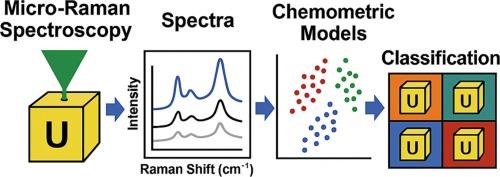用微拉曼光谱对固态U材料进行分类的化学计量模型的建立。
IF 4.6
2区 化学
Q1 SPECTROSCOPY
Spectrochimica Acta Part A: Molecular and Biomolecular Spectroscopy
Pub Date : 2025-09-25
DOI:10.1016/j.saa.2025.126989
引用次数: 0
摘要
辨别在环境取样中发现的铀颗粒对监测和平利用核材料具有重要意义。本研究成功建立了类类比软独立建模(SIMCA)文库,利用拉曼光谱对α-U3O8、UO2、UO2(NO3)2·6H2O (UNH)和UO2O2·4H2O (studtite)组成的四类体系在基质颗粒和附加异常值存在下进行分类。每种类型的许多颗粒之间的光谱变异性显示出明显的差异,作为颗粒大小的函数,相对于水化状态和每种类型的潜在氧化相。使用无监督和有监督的化学计量模型来解释类间变异性。有监督的SIMCA模型对每个U类具有合理的灵敏度,并通过返回光谱是否属于一类而具有高度的特异性。这项工作展示了拉曼光谱特征和化学计量学如何用于区分U材料彼此之间以及与燧石粘土等基质材料。将概述的化学计量学方法与拉曼图谱序列相结合,可以提供一种快速、无损的技术来表征环境采样、核取证和工业应用背景样品中各种铀化合物的化学成分。本文章由计算机程序翻译,如有差异,请以英文原文为准。

Development of chemometric models to classify solid-state U materials by micro-Raman spectroscopy
Discerning uranium (U) particles found in environmental sampling is of interest for monitoring the peaceful use of nuclear material. In this study, a soft independent modeling of class analogy (SIMCA) library was successfully developed for the classification of a four-class system consisting of α-U3O8, UO2, UO2(NO3)2·6H2O (UNH), and UO2O2·4H2O (studtite) by Raman spectroscopy in the presence of matrix particulates and additional outliers. Spectral variability between numerous particles of each type revealed appreciable differences as a function of particle size with respect to hydration state and potential oxide phase within each class. Interclass variability was accounted for using both unsupervised and supervised chemometric models. The supervised SIMCA model displayed reasonable sensitivity for each U class and a high degree of specificity by returning whether a spectrum belonged to one class or not. This work demonstrates how Raman spectral features and chemometrics can be used to distinguish U materials from one another and from matrix materials such as flint clay. Combining the outlined chemometric approach with Raman mapping sequences could provide a rapid, nondestructive technique to characterize the chemical composition of a diverse collection of U compounds amid background samples for environmental sampling, nuclear forensics, and industrial applications.
求助全文
通过发布文献求助,成功后即可免费获取论文全文。
去求助
来源期刊
CiteScore
8.40
自引率
11.40%
发文量
1364
审稿时长
40 days
期刊介绍:
Spectrochimica Acta, Part A: Molecular and Biomolecular Spectroscopy (SAA) is an interdisciplinary journal which spans from basic to applied aspects of optical spectroscopy in chemistry, medicine, biology, and materials science.
The journal publishes original scientific papers that feature high-quality spectroscopic data and analysis. From the broad range of optical spectroscopies, the emphasis is on electronic, vibrational or rotational spectra of molecules, rather than on spectroscopy based on magnetic moments.
Criteria for publication in SAA are novelty, uniqueness, and outstanding quality. Routine applications of spectroscopic techniques and computational methods are not appropriate.
Topics of particular interest of Spectrochimica Acta Part A include, but are not limited to:
Spectroscopy and dynamics of bioanalytical, biomedical, environmental, and atmospheric sciences,
Novel experimental techniques or instrumentation for molecular spectroscopy,
Novel theoretical and computational methods,
Novel applications in photochemistry and photobiology,
Novel interpretational approaches as well as advances in data analysis based on electronic or vibrational spectroscopy.

 求助内容:
求助内容: 应助结果提醒方式:
应助结果提醒方式:


